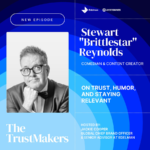Why embracing a social-first philosophy to marketing may be the risk-free “risk” brands are searching for
By Jason Mitchell, CEO, Movement
If recent studies are to be believed, brands are starting to feel the negative impact of their risk-adverse ways. Only 13% see themselves as risk-friendly, despite reports estimating that brands that leave their comfort zones earn four times higher profit margins and long-term revenue growth. It’s no wonder that companies are chasing smart ways to take more creative risks in the face of emerging tech, shrinking budgets and the demand for partners that can move at the speed of culture.
As brands look for solutions, social media marketing remains a blind spot for most. And that’s understandable – it’s seen as one of the least risky marketing investments there are. Today, it feels like table stakes, in part because everyone does it – often poorly. But also because it’s a part of our cultural framework. Brands realize they will be on social media regardless of whether they have channels or not. So, it becomes an afterthought.
However, while there is definitely more and more advertising budget going to social media than ever, it still doesn’t align with the value social media creates. Every day I see brands failing to truly understand the value of getting people to talk about their brand in a positive way on social media. If they did, they’d completely change the paradigm of how they think about social media, shifting their approach to make it not just a paid media channel, but the core of their entire brand strategy. But ask any brand marketer and they’ll likely tell you that committing to a social-first philosophy is too risky.
In truth, the bigger risk is complacency in the face of a changing industry. And if brands are finally starting to warm to the idea of riskier creative that more and more reflects how people live their lives online, it’s time to let social media brand-building take the lead.
A risk worth taking
Perceptions of social media marketing are changing – and with it, the idea that social media marketing is just a channel to fill. More and more people who were social media managers are moving into senior positions and that’s driving brands to invest in social in greater capacities. But there’s still a challenge. Years ago, it was hard to convince clients to be on social media. Today, we need to convince them that being on social media isn’t enough. Instead, brands have to do things that are really interesting, creative, and push boundaries to get noticed on social and beyond.
When brands decide to opt for more traditional approaches to protect themselves during uncertain times, they only risk sliding into irrelevance. Brands like Duolingo and Liquid Death have realized this, demonstrating that audiences are hungry for riskier, social-powered ideas and content while earning big headlines in the process. While they were initially slow to get on social media, legacy brands like Apple have embraced a social-first approach too with its long-running #shotonanphone campaign. Using OOH billboards of iPhone users’ photos to promote their branded hashtag, they were able to generate millions upon millions more pieces of user-generated content that had a massive impact.
CeraVe took a similarly social-led approach, using social listening to see that people were organically connecting Michael Cera to CeraVe, which inspired a Super Bowl campaign that not only generated a huge amount of conversation but fueled CeraVe’s YoY growth. More recently, e.l.f. Cosmetics earned social attention and broader cultural cachet by sending a care package to sailor Oliver Widger, who had gone viral for his journey across the Pacific Ocean with his cat, Phoenix. While each of these examples began as seemingly offline executions, they were rooted in “risky” social media-led principles and strategies that fueled entire omni-channel campaigns.
Sharing the risk and responsibility
It may seem counter intuitive, but taking these types of creative risks doesn’t need to be risky, so long as brands take the necessary steps to rethink their internal processes for a social-first approach.
It’s crucial to look at it from a cultural and operational perspective. It’s about trust – empowering stewards of the brand to make decisions, which enables them to move quickly. Then, in order for them to make the right decisions, there needs to be a framework in place that details what issues and subjects the brand engages with and what it doesn’t.
Next, there needs to be guidance for how the brand engages, including tone of voice and scale. Afterall, reacting to a tweet is different from sending a care package to an influencer, which is also different from creating an event. And, when it comes to teams managing social channels, there needs to be some level of autonomy – giving them permission and budget to do some things on their own instead of requiring larger buy-in. Lastly, leaders need to push their team to be proactive, using social media listening to see what is happening across the internet and then engaging in ways that make sense for the brand.
As social media drives more of our culture, risk-taking will become a necessity that brands can’t afford to ignore. It’s already impacting everything from the teams we build to the countless ways marketing is conceptualized and produced. Thankfully, it’s also a challenge that social media marketing is uniquely built for. Let’s treat it as much more than an afterthought.











